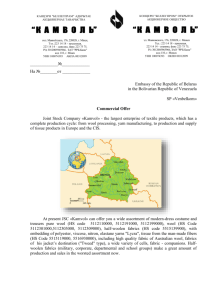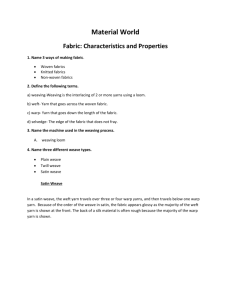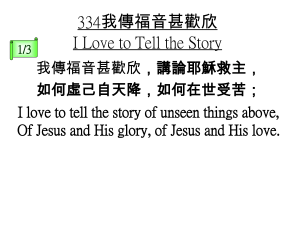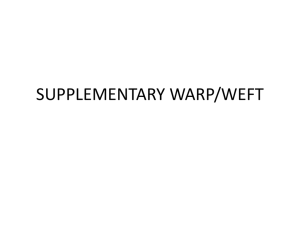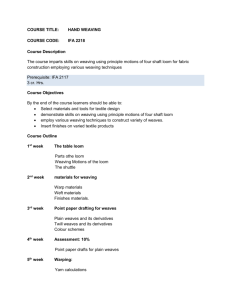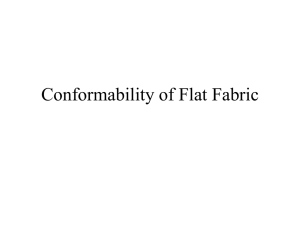Lecture 2 Elementary Weaves: Plain, Twill, Satin/Sateen
advertisement
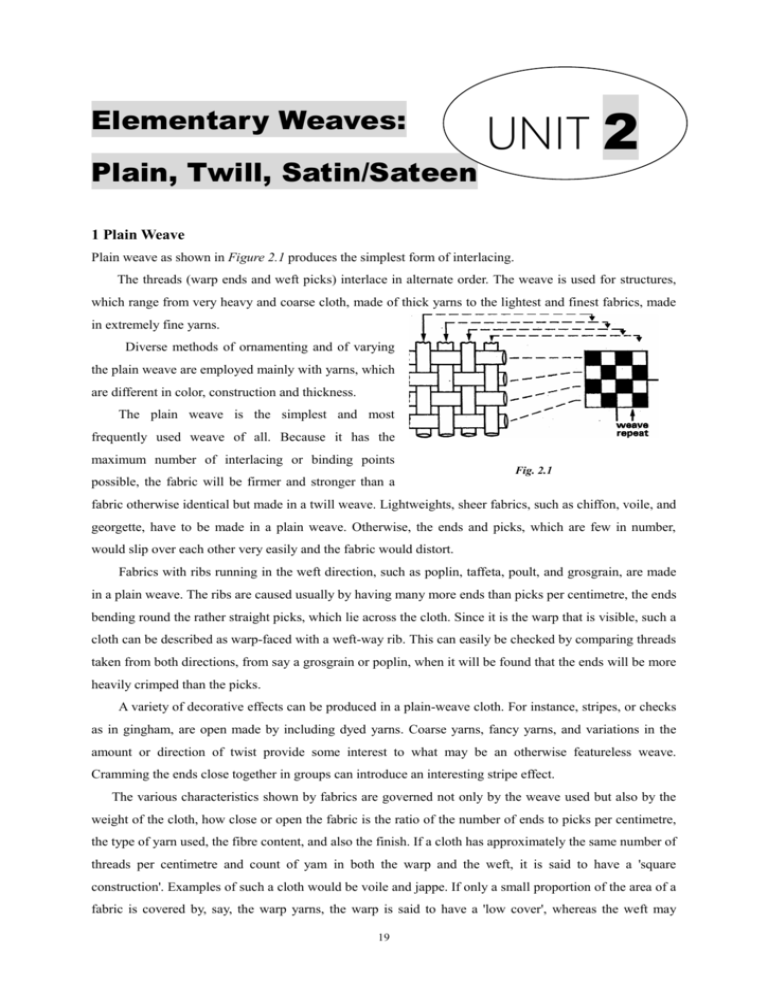
Elementary Weaves: Plain, Twill, Satin/Sateen UNIT 2 1 Plain Weave Plain weave as shown in Figure 2.1 produces the simplest form of interlacing. The threads (warp ends and weft picks) interlace in alternate order. The weave is used for structures, which range from very heavy and coarse cloth, made of thick yarns to the lightest and finest fabrics, made in extremely fine yarns. Diverse methods of ornamenting and of varying the plain weave are employed mainly with yarns, which are different in color, construction and thickness. The plain weave is the simplest and most frequently used weave of all. Because it has the maximum number of interlacing or binding points Fig. 2.1 possible, the fabric will be firmer and stronger than a fabric otherwise identical but made in a twill weave. Lightweights, sheer fabrics, such as chiffon, voile, and georgette, have to be made in a plain weave. Otherwise, the ends and picks, which are few in number, would slip over each other very easily and the fabric would distort. Fabrics with ribs running in the weft direction, such as poplin, taffeta, poult, and grosgrain, are made in a plain weave. The ribs are caused usually by having many more ends than picks per centimetre, the ends bending round the rather straight picks, which lie across the cloth. Since it is the warp that is visible, such a cloth can be described as warp-faced with a weft-way rib. This can easily be checked by comparing threads taken from both directions, from say a grosgrain or poplin, when it will be found that the ends will be more heavily crimped than the picks. A variety of decorative effects can be produced in a plain-weave cloth. For instance, stripes, or checks as in gingham, are open made by including dyed yarns. Coarse yarns, fancy yarns, and variations in the amount or direction of twist provide some interest to what may be an otherwise featureless weave. Cramming the ends close together in groups can introduce an interesting stripe effect. The various characteristics shown by fabrics are governed not only by the weave used but also by the weight of the cloth, how close or open the fabric is the ratio of the number of ends to picks per centimetre, the type of yarn used, the fibre content, and also the finish. If a cloth has approximately the same number of threads per centimetre and count of yam in both the warp and the weft, it is said to have a 'square construction'. Examples of such a cloth would be voile and jappe. If only a small proportion of the area of a fabric is covered by, say, the warp yarns, the warp is said to have a 'low cover', whereas the weft may 19 provide a higher degree of cover, perhaps by virtue of its coarser yarns. In fact, the combination of the amount of cover provided by the warp and weft yarns determines the openness or closeness of the cloth. A voile will have a much lower cover than a cambric, and a dress poult will have a greater cover than either. Some fabrics made from the plain weave are listed below and are defined. Group 1 Group 2 Group 3 batiste afgalaine chiffon buckram crepe crepe-de-chine cambric delnine grosgrain lawn domet jappe organdie flannel organza poplin panama poult voile thornproof tweed shantung tropical suiting taffeta The fabrics in Group 1 were commonly produced from cotton or linen, those in Group 2 from wool, and those in Group 3 from silk. Nowadays some of these fabrics may be made from man-made fibres. 2 Twill Weave (simple or regular) The order of interlacing causes diagonal lines in the cloth. The weaves are employed for the purpose of ornamentation to produce a cloth of greater weight, closer setting and better draping quality than can be achieved with similar yarns in plain weave. The smallest number of threads on which it is possible to construct twill is three. It is first necessary to decide upon the number of threads in the repeat and to consider the general prominence of the main line. With a comparatively small size repeat, 8 shafts, it is possible to obtain a considerable variety of designs. Large twills based on 16 or 20 shafts repeat offer almost infinite scope for experimentation. If warp and weft yarns are similar in quality and count both may be floated equally. Warp faced twills are constructed with a greater number of ends per cm than picks per cm and Weft faced twills vice versa. The intersecting of the threads gives the cloth firmness and the more frequent the intersections are the firmer the cloth is. Excessive long floats give a slack, poorly bound construction, unlikely to produce a serviceable fabric. Twills are indicated as follows: 1 2 above the line is “warp up”; below the line is “warp down” The rule to establish the size of repeat is to add all interlacing above the line to the sum of interlacing below the line. Z= diagonal lines from left to right, S= diagonal lines from right to left. Continuous diagonal lines characterize twill weaves; they cannot be produced on less than a three 20 thread repeat. See Figures 2.2, 2.3 and 2.4. It will be noticed that some of the twill lines run up to the right and are known as right-hand twills or 'Z twills'. Twills with their diagonal lines running in the opposite direction are known as left-hand twills or 'S twills’ (the centre stroke of the letters Z and S denote the direction in which the twill lines run). Fig. 2.2 2/2 Twill (Z direction) Fig. 2.3 1/2 Twill (S direction) Fig. 2.4 3/1 Twill (S direction) Taking a '2/2' as an example, the term 2/2, which may also be written 2/2 signifies that each end floats over two successive picks and under two successive picks, with each adjacent end to the right stepping up one pick, resulting in a 'Z twill'. It is possible to have a 2/2 twill stepping down one, which, of course, would produce an 'S twill'. Twill weaves with a 2/2, 3/3, or 4/4 repeat are regarded as balanced twills. If they are used in a fabric of square construction, the warp and weft will be equally prominent on both faces of the fabric. An example of such a fabric is a serge, which is made in a 2/2 twill. On the other hand, weaves such as 1/2 and 3/1 twill are regarded as 'unbalanced' twills, since in the first example the right side of the fabric will be composed mainly of weft threads. The cloth is, therefore, referred to as 'weft-faced', and the 3/1 twill produces a 'warp-faced' fabric such as a denim. See Figures 2.3 and 2.4. The prominence of the twill lines in a simple twill weave depends to some extent on the length over which the threads 'float' across each other. For instance, a 2/1 twill has a shorter float than a 4/1 twill. There is, of course, a limit to the length of float that can be used, since fabrics with very long floats may be unstable and liable to snag. The use of warp and weft yams differing in colour, diameter, or twist may also enhance the twill effect. It is possible in a twill weave to accommodate more ends and picks in the fabric than the maximum that can be accommodated in a plain weave using the same count of yarn. Consequently, similar yarns can be made into heavier fabrics by using twill rather than plain weave. Twill weaves are always less stiff than plain weaves made from the same yarns and with the same ends and picks per centimeter. Twill weaves are often used simply to create surface interest, It is possible for the fabric designer to use attractive or expensive yarns in the warp, which will show, and incorporate the less attractive or inexpensive yarns in the weft, which may be scarcely visible on the face of the cloth. Some fabrics made from twill weaves are listed below. Croup 1 Denim Jean Regatta Regina Silesia Group 2 dog's-tooth check flannel gaberdine Glen check whipcord 21 Croup 3 foulard surah 3 Satin (warp faced construction) and Sateen Weave (weft faced construction) Fabrics made from these weaves have a typically smooth and generally lustrous appearance without strong diagonal lines of the type associated with twill weaves. The satin weave is used in fabrics made from a wide range of fibres. Flat continuous filament yarns are very commonly used, since their bright lustrous surface enhances the smooth appearance of the fabric. However, cotton yarn, mercerised or unmercerised, and worsted yarn are both put into these weaves, and it follows that whilst a satin has a smooth surface it may not necessarily have the lustre which is sometimes erroneously considered to be an essential requirement of the fabric. A satin is warp-faced, whereas sateen is a weft-face fabric. An examination of the weaves illustrated in Figures 2.5, 2.6 and 2.7 shows the intersections between the warp and weft to be distributed so that they can be somewhat concealed on the face of the fabric. In fact, in a closely woven cloth the floats tend to overlap the binding points and consequently make them less conspicuous. Satin and sateen weaves commonly repeat on 5 or 8 threads and are generally called a 5-end or 8-end satin or sateen. Satin fabrics are available in a range of weights suitable for lightweight linings, lingerie, slippers, foundation garments, heavy dress fabrics suitable for evening wear, and bridal gowns. Generally, the heavier satins are made with an 8-end repeat, and the threads per centimetre and cloth 'cover' are greatly increased. The smooth surface of a satin lends itself to printing, machine embroidery, and embossing to produce lustrous patterned effects. Sateens are frequently made from cotton, and apart from being printed and being Fig. 2.5 5-end satin Fig. 2.6 8-end satin Fig. 2.7 5-end sateen suitable for dress fabrics, the weave is used in such fabrics as Italian for lining and closely woven downproof sateens for eiderdowns. Some fabrics made from satin and sateen weaves are listed below. Group 1 Group 2 Group 3 Italian doeskin cloth duchesse satin satin drill satin-back gaberdine satin-back crepe Venetian satin marocain SATIN AND SATEEN WEAVES In pure satin and sateen weave the surface of the cloth consists almost entirely either of warp or weft float. This results in the production of fabrics with a maximum degree of smoothness and luster and without prominent weave features. The smallest number of threads on which it is possible to construct a satin/sateen is five. Satins are particularly suitable for displaying colours in stripe form. Brilliant effects are produced because the lustrous unbroken cloth surface enhances the brightness of the colours. Different materials can 22 also be effectively combined in the warp. Further variety can be achieved by combining satin with other weaves. In regular satin/sateen weaves the count (or move, or step) is more than one. As the intersections do not support each other, but the distance moved each time is equal and regular a certain degree of twilling is formed in the cloth. In the best regular satins/sateens the points of intersection are equally distributed over the repeat area. If the “twill lines” and the “yarn twist” run in the same direction, an almost untwilled surface is formed. Fabrics with insufficient close settings exhibit poor strength due to slippage. The rule to establish the size of repeat is to add all interlacing above the line to the sum of interlacing below the line. Indications of “count” numbers: 3↑=count warp-way (vertical), 2→=count weft-way (horizontal). Count numbers: repeat 5 ends/picks = 2 or 3 repeat 7 ends/picks = 2 or 5, 3 or 4 repeat 8 ends/picks = 3 or 5 repeat 9 ends/picks = 2 or 7, 4 or 5 repeat 10 ends/picks = 3 or 7 repeat 11 ends/picks = 2 or 9, 3 or 8, 4 or 7, 5 or 6 repeat 12 ends/picks = 5 or 7 repeat 13 ends/picks = 3 or 10, 4 or 9, 5 or 8 repeat 14 ends/picks = 3 or 11, 5 or 9 Fig.2.8 23 MORE EXAMPLES OF WEFT SATEEN WEAVES (FIGURE 2.9~2.12). Fig. 2.9 Fig. 2.10 Fig. 2.11 Fig. 2.12 MORE EXAMPLES OF WARP SATIN WEAVES (FIGURE 2.13). Fig. 2.13 24



